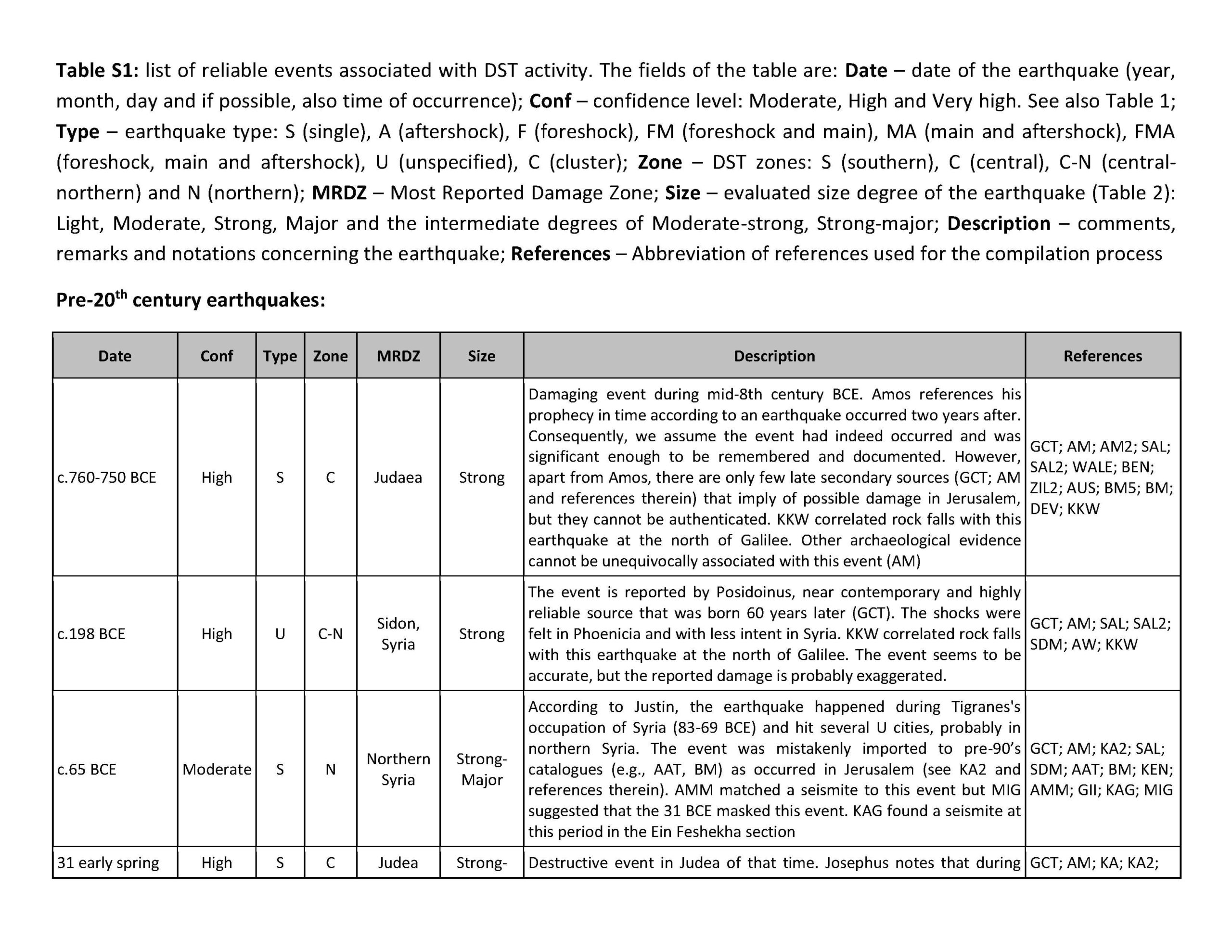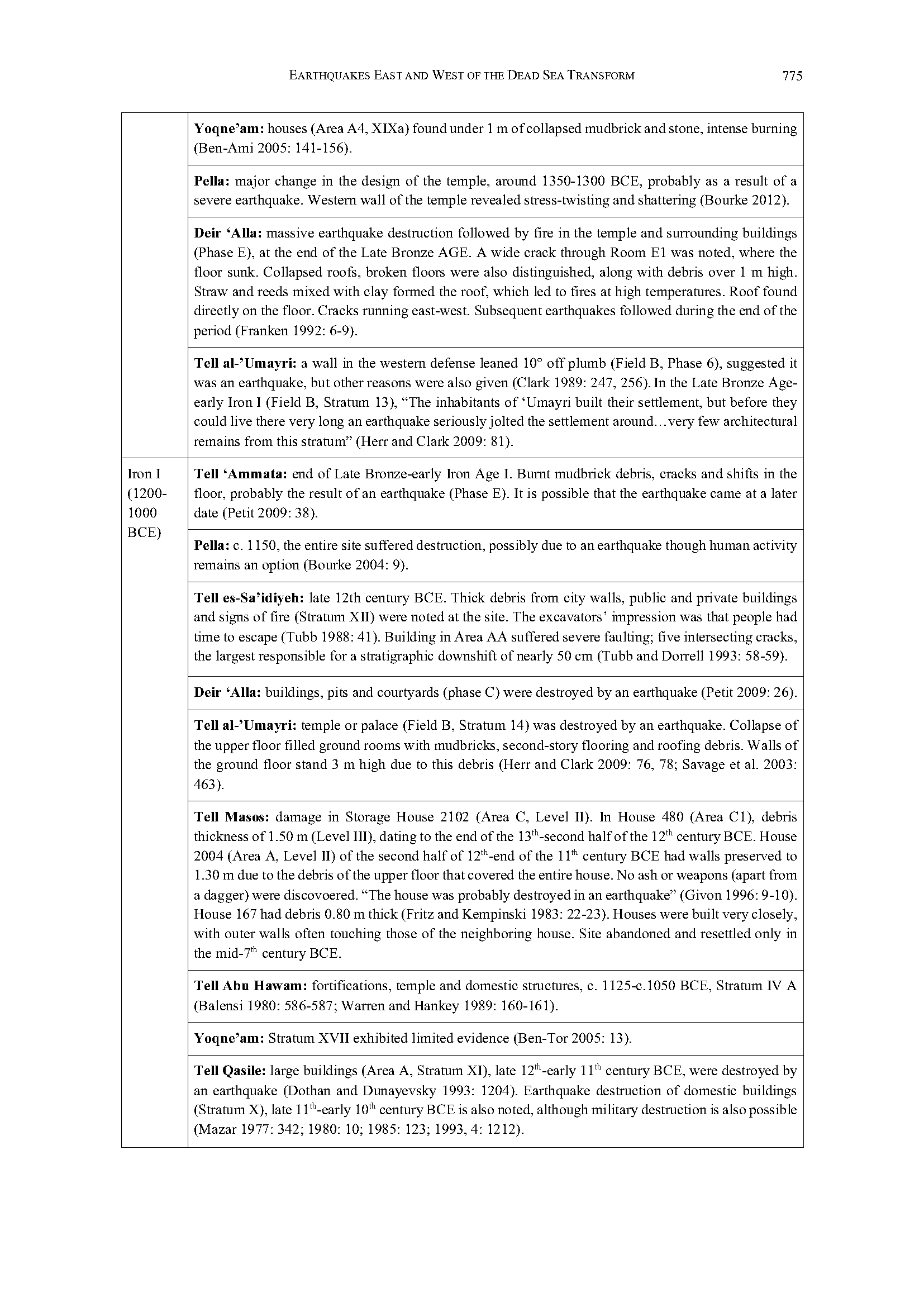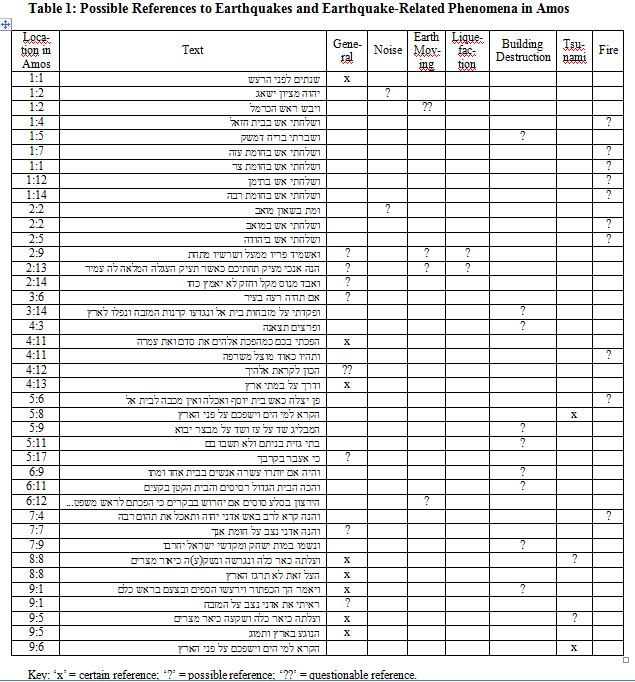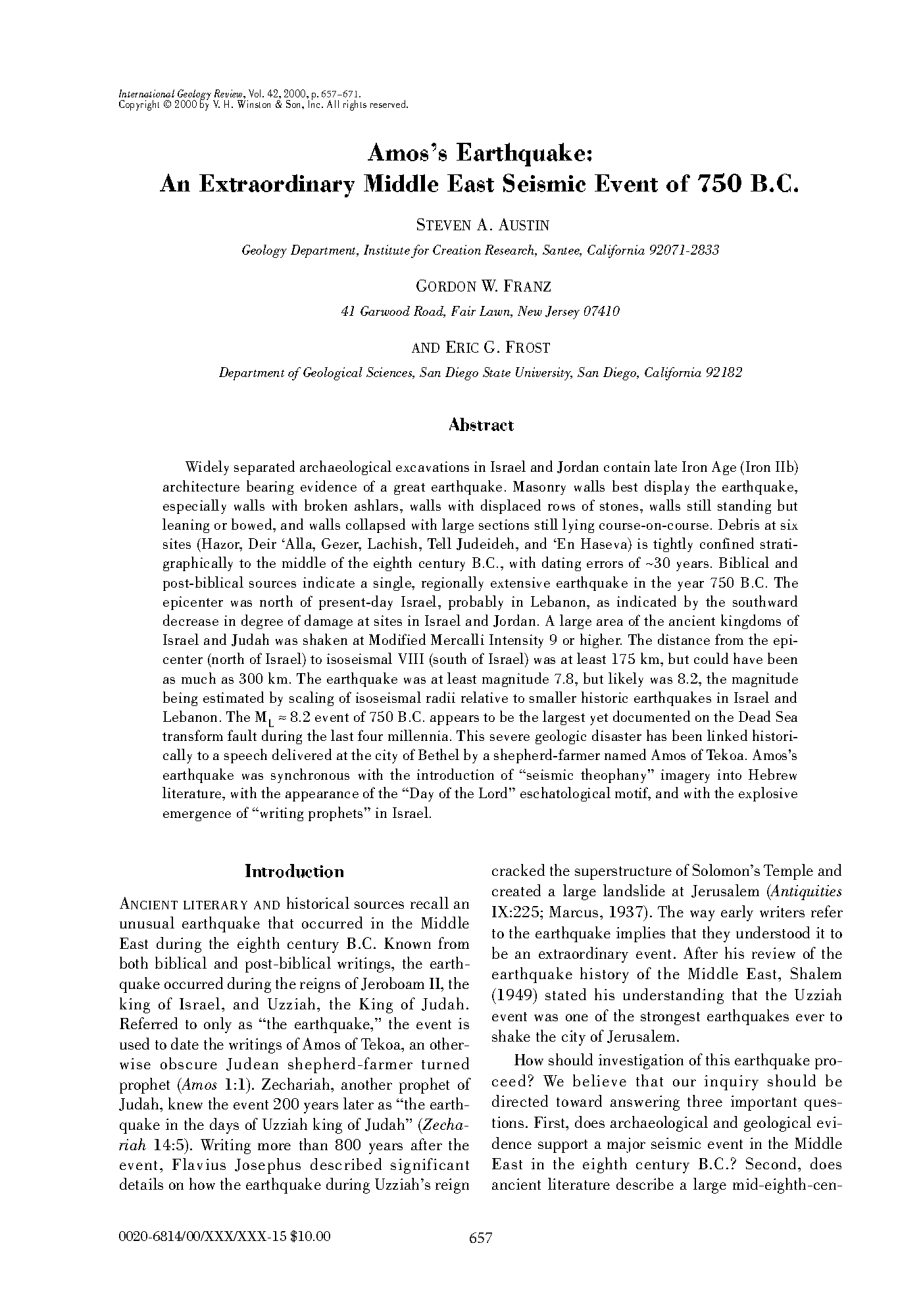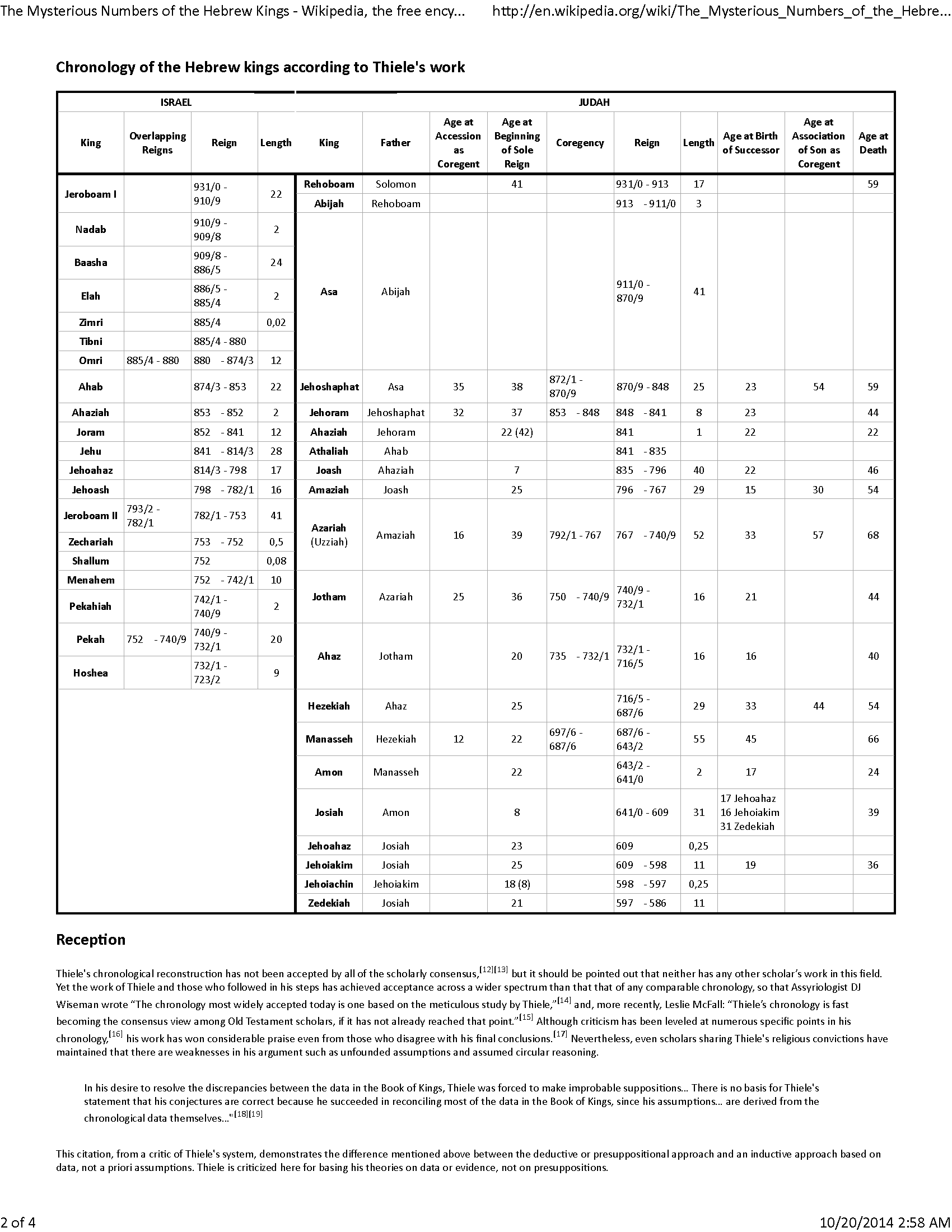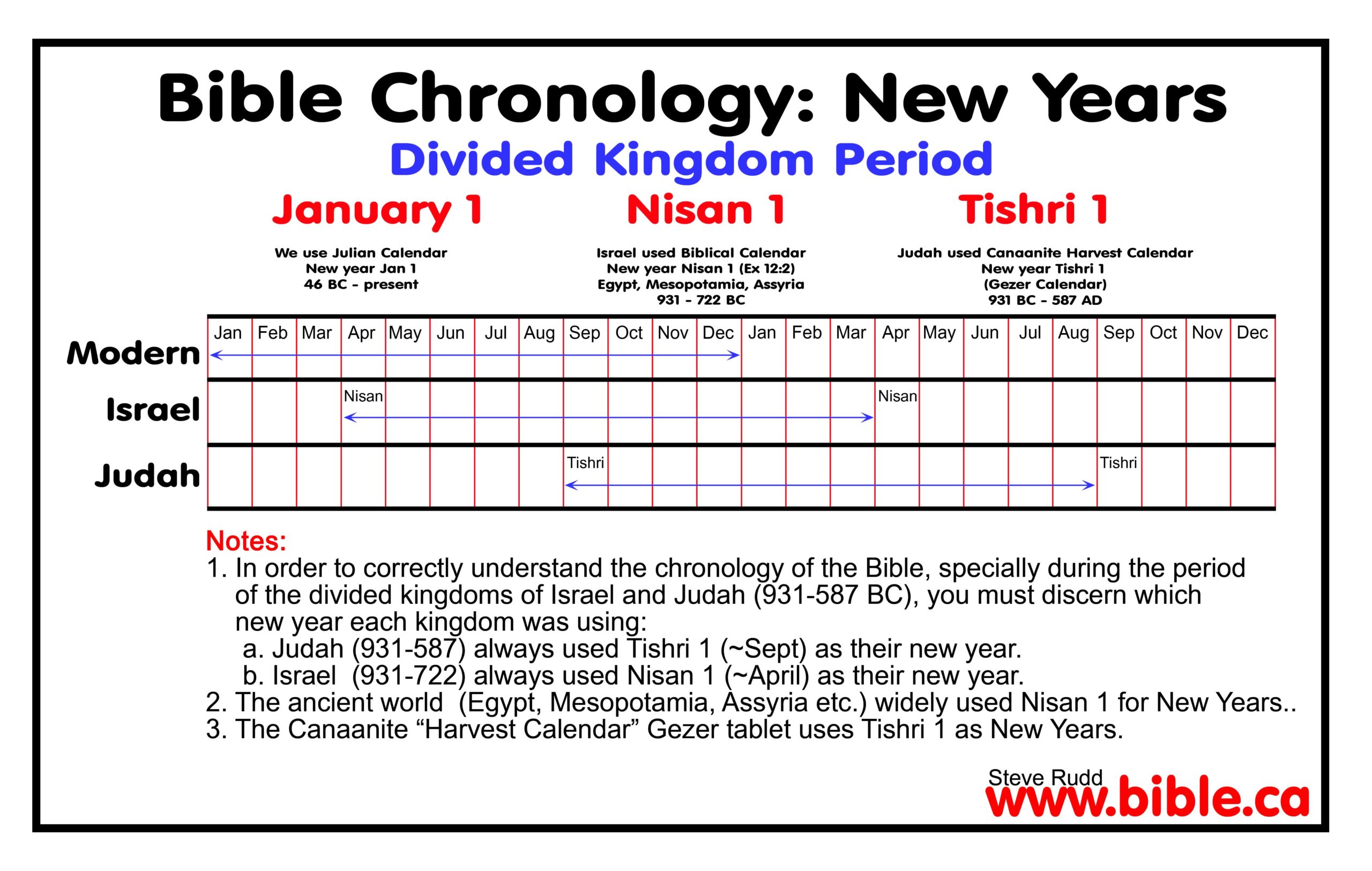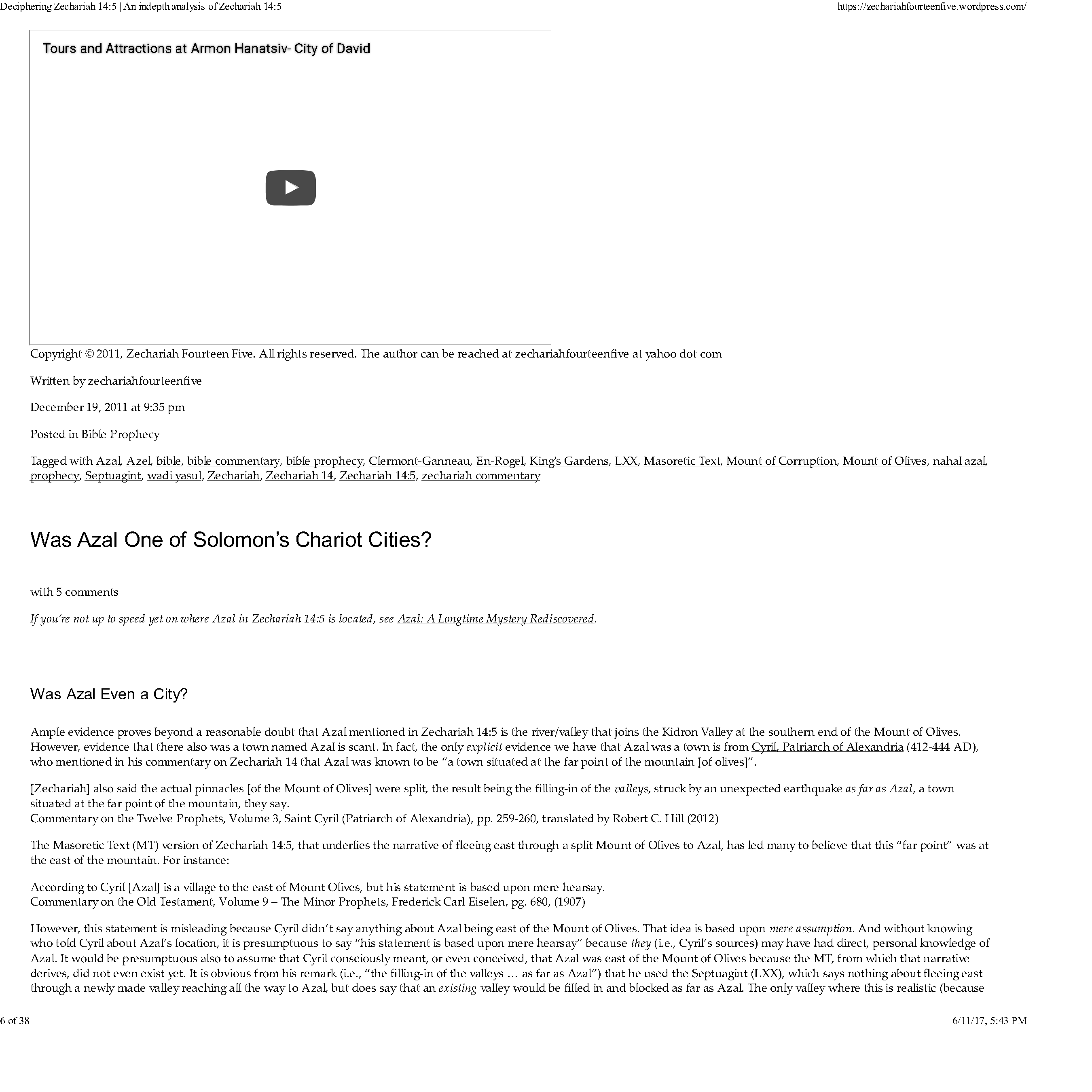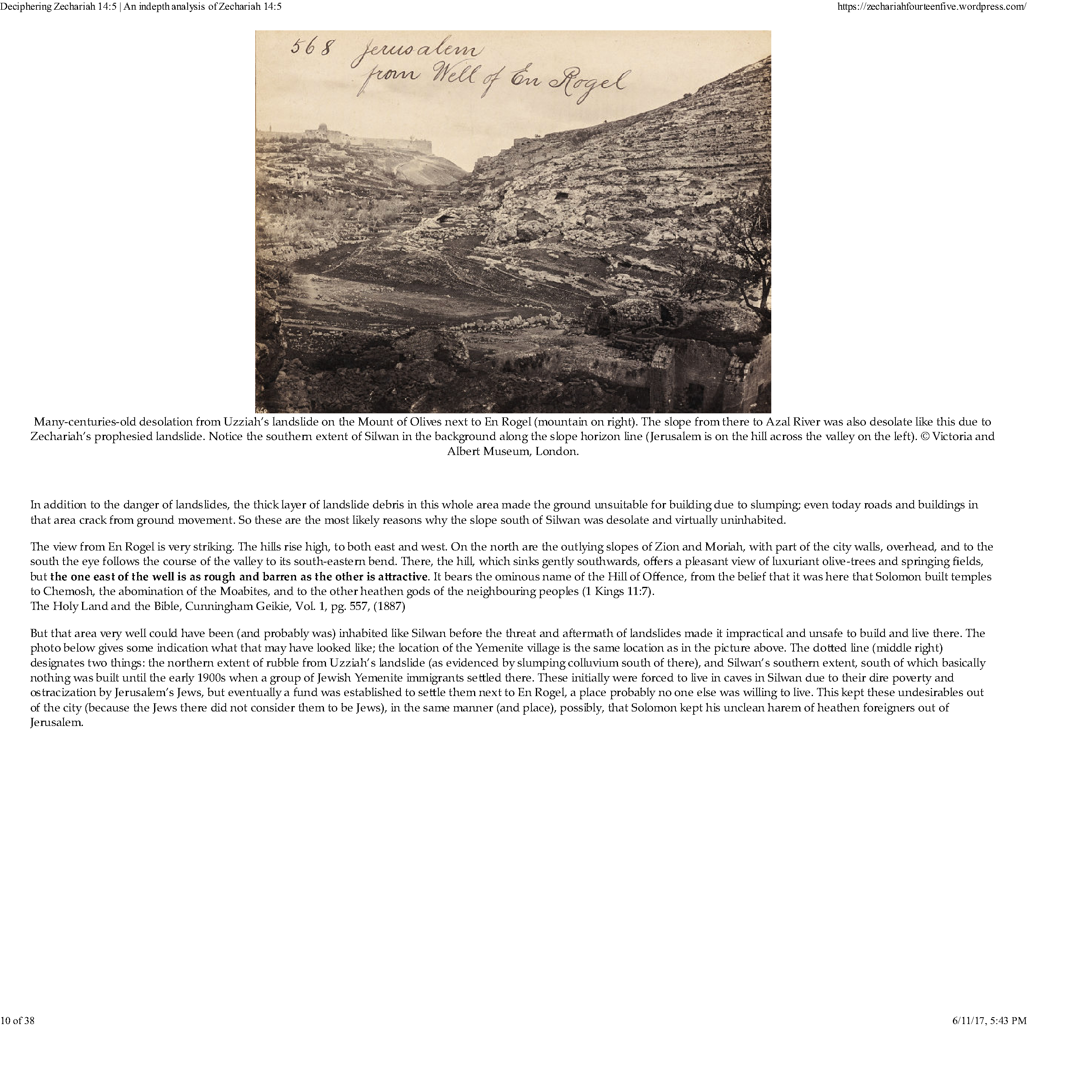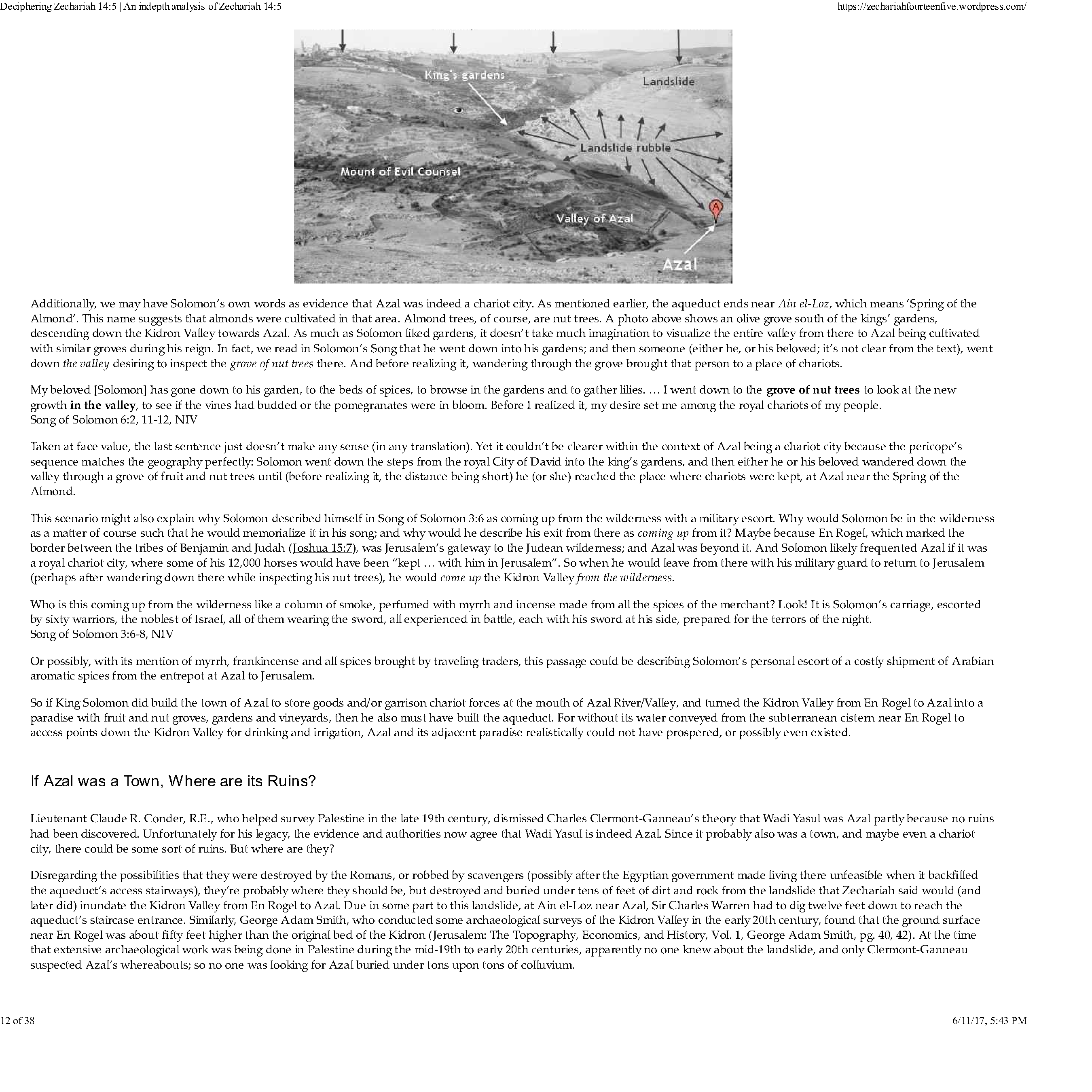[1] Amos says that the prophet received visions ‘. . . during
the reigns of Uzziah king of Judah and Jeroboam son of
Jehoash king of Israel, two years before the earthquake . . .’
(Amos, I. 1).
[2] ‘. . . they shall go into the holes of the cracks and into
the caves of the earth when He arises to shake (terrify) the
earth . . .’ (Isa. II. 19, 21).
[3.1] ‘. . . the Lord will go out fully armed for war, to fight against
those nations. That day his feet will stand upon the Mount
of Olives, to the east of Jerusalem, and the Mount of Olives
will split apart, making a very wide valley running from east
to west, for half the mountain will move towards the north
and half toward the south. You will escape through that valley,
for it will reach across to Azel. You will escape as your
people did long centuries ago from the earthquake in the
days of Uzziah, king of Juda . . . [c. 767–753 BC]’ (Zech.
xiv. 4–5).
[3.2] ‘And the mountain will split in half, forming
a wide valley that runs from east to west . . . Then you people will
escape from the Lord’s mountain, through this valley,
which reaches to Azal. You will run in all directions, just
as everyone did when the earthquake struck in the time of
King Uzziah of Judah.’ (Contemporary English Version).
[3.3] ‘And the Mount of Olives shall be split in two from east
to west by a very wide valley; so that one half of the
Mount shall withdraw northward, and the other half southward . . . And the valley of my mountains shall be stopped
up, for the valley of the mountains shall touch the side of
it; and you shall flee as you fled from the earthquake in the
days of Uzzi’ah king of Judah.’ (Revised Standard Version).
[3.4] ‘And the Mount of Olives shall be split in two from east
to west by a very great valley; and half of the mountain
shall remove toward the north and half of it toward the
south . . . And you shall flee by the valley of my mountains;
for the valley of the mountains shall reach to Azel; and you
shall flee, as you fled from before the earthquake in the days
of Uzziah king of Judah.’ (Amplified Bible).
[3.5] ‘And the Mount of Olives shall be split in the midst thereof
toward the east and toward the west, and there shall be a
very great valley; and half of the mountain shall remove
toward the north, and half of it toward the south . . . And you
shall flee by the valley of my mountains; for the valley of the
mountains shall reach unto Azel. And you shall flee, like as
you fled from before the earthquake in the days of Uzziah.’
(American Standard Version).
[3.6] ‘And the Mount of Olives shall cleave in the midst thereof
toward the east and toward the west, and there shall be a
very great valley; and half of the mountain shall remove
toward the north and half of it toward the south . . . And you
shall flee by the valley of my mountains; for the valley of the
mountains shall reach unto Azal; you shall even flee, like as
you fled from before the earthquake in the days of Uzziah
king of Judah.’ (Darby English Version).
[3.7] ‘And the Mount of Olives shall cleave in the midst thereof
toward the east and toward the west, and there shall be a
very great valley; and half of the mountain shall remove
toward the north, and half of it toward the south . . . And you
shall flee to the valley of the mountains; for the valley shall
reach unto Azal; you shall flee, like as you fled from before
the earthquake in the days of Uzziah king of Judah.’ (King
James Version).
[4] ‘And ye shall flee to the valley of the mountains;
for the valley of the mountains shall reach unto Azal . . .’ (Masoretic
text).
[5] ‘And the valley of my mountains shall be stopped up; for
the valley of the mountains shall touch the side of it . . .’
(Revised text).
[6] ‘. . . a great earthquake shook the ground and a rent was
made in the temple, and the bright rays of the sun shone
through it, and fell upon Uzziah’s face, insomuch that the
leprosy seized upon him immediately. And before the city,
at a place called Eroge, half the mountain broke off from
the rest on the west, and rolled itself four furlongs and stood
still at the east mountain, till the roads, as well as the king’s
gardens, were spoiled by the obstruction . . .’ (Joseph.AN:
IX. x. 4).
[6a] ‘. . . when leprosy appeared on Uzziah’s brow, at the same
moment the temple split open and the fissure extended for
twelve miles in each direction . . .’ (Nathan ha-Bavli. ix).
[7] ‘. . . the posts of the temple moved when the Lord spoke . . .’
(2 Chron., XXVI. 16–17; 2 Kings XV.1–7).
[8] Timna (Tel Batash)
(Rotherberg and Lupu 1967, 59; Rothenberg 1972, 128,
149–150; Mazar 1993 = in fact 1160–1156).
[9] Tel Beersheba (Tel Sheva)
Estimated period of occurrence: 760 BC.
Extract of pertinent statement by author relating to earthquake damage:
‘. . . and Beersheva depends largely upon the opinion of Aharoni,
thus far unsupported by an adequate publication, see Y. Aharoni et al., Beer-Sheba I. Excavations at
Tell Beer-Sheba, 1969–1971 Seasons (Tel Aviv 1973) 107.’
(Dever 1992, 35* n. 10).
‘At Tel Beersheba, Strata V and IV cover the period
equivalent to that of Stratum XI at Tel Arad. The plan of
Stratum III at Tel Beersheba is, again, drastically
different from that of Stratum IV. The former solid city wall
and city gate were completely razed, and a new fortification
system was constructed. We subscribe to the “low chronology”,
these changes may not be attributed to Shishak’s
raid or to the division of the alleged United Monarchy. If
so, what generated such a cultural shift? Since typological
modification runs parallel to drastic changes in the design
of settlements, as observed at Tel Beersheba and Lachish,
they should be related to significant events. Tentatively this
development might be associated with a severe earthquake
dated to c. 760 BCE, based on biblical references (Dever
1992). A strong earthquake in the southern part of the
Judean Kingdom might explain the total destruction of the
upper parts of the fortification systems at Tel Arad XI and
Beersheba IV and the need to rebuild them in Strata X and
III, respectively’ (Herzog 2002, 97–98).
[10] Tel Arad
Estimated period of occurrence: c. 760 BC.
Extract of pertinent statement by author relating to earthquake damage:
‘At Arad, a new fortress was erected that only partially used the previous casemate wall.
A solid wall surrounded by a glacis protected the fortress of Stratum X.
A new imposing gate and an elaborate water system were
constructed in this phase. As shown above, the temple, too,
was first erected in this stratum. At Tel Beersheba, Strata V
and IV cover the period equivalent to that of Stratum XI at
Tel Arad . . . Tentatively this development might be associated
with a severe earthquake dated to c. 760 BCE, based
on biblical references (Dever 1992). A strong earthquake
in the southern part of the Judean Kingdom might explain
the total destruction of the upper parts of the fortification
systems at Tel Arad XI and Beersheba IV and the need to
rebuild them in Strata X and III, respectively.
The pottery assemblage of Stratum X at Tel Arad is remarkably
different from that of Stratum XI and exhibits new
forms that display similarity to the assemblages known from
the destruction layers of the end of the 8th century (Aharoni
and Aharoni 1976).
The time span of the three strata was apparently
fairly short. Attributing the destruction of the fortress of
Stratum XI to the earthquake of ca. 760 BCE, the
construction of the Stratum X fortress may be dated to 750 BCE. The
circumstances of the destruction of the Stratum X fortress
and its reconstruction in Stratum IX are unclear’ (Herzog
2002, 97–98).
‘As stated above, the material culture of Stratum
XI resembles that of Lachish Level IV. The excavators
attribute the destruction of Level IV at Lachish to an
earthquake during the reign of Uzziah in 760 or 750 BCE, so
that this date may mark the end of Stratum XI at Arad and
the establishment of Stratum X. If we accept this view, then
Stratum XI existed for a lengthy period, approximately 150
years’ (Singer-Avitz 2002, 162).
[11] Lachish (Hesy)
Estimated period of occurrence: 760 BC.
Extract of pertinent statement by author relating to earthquake damage:
‘Level IV apparently came to a sudden end, but it
seems clear that this was not caused by fire. On the other
hand, the lower house of Level III and the rebuilt enclosure
wall followed the lines of the Level IV structures, while the
Level IV city wall and gate continued to function in Level
III; these facts point towards the continuation of life
without a break. Considering that the fortifications remained
intact, we can hardly identify this level with the city which
was stormed and completely destroyed in the fierce
Assyrian attack. Here we may mention M. Kochavi’s suggestion
(made during a visit to the excavations in 1976 and quoted
here with his kind permission) that the end of the Level IV
structures may have been caused by an earthquake.
A natural catastrophe of this sort would, perhaps, be compatible
with the above findings. Of interest in this connection is the
earthquake mentioned in Amos 1:1 and Zech. 14:5, which
occurred around 760 BCE during the reign of Uzziah, king
of Judah’ (Ussishkin 1977, 52).
‘The case of Lachish IV is perhaps the strongest’
(Dever 1992, 35* n. 10).
‘Since typological modification runs parallel to
drastic changes in the design of settlements, as observed
at Tel Beersheba and Lachish, they should be related to
significant events. Tentatively this development might be
associated with a severe earthquake dated to c. 760 BCE,
based on biblical references (Dever 1992)’ (Herzog 2002,
97).
[12] Iraq al Amir
(Butler 1907, 13 = 760?)
[13] Tel Gezer
Estimated period of occurrence: 760 BC.
Extract of pertinent statement by author relating to earthquake damage:
‘According to Macalister, a number of ashlar towers had been inserted into the Late Bronze Age Outer Wall
by Solomonic engineers. In order to test this claim it was
decided to locate his “Tower VII” (situated immediately
north of the “Egyptian Governor’s Residency”, according
to Macalister’s plan) and open two soundings – one against
each of the inner and outer faces of the “tower” – in order
to determine if indeed the “towers” were constructed in the
manner and at the time Macalister claimed (see Plates 4,
6, and 19). After clearing off the top of the Outer Wall,
however, it was discovered that Macalister’s “Tower VII”
was not a tower at all, but rather an offset that was similar to what he found further west in his trenches 22–29,
a stretch of wall which he described as “rebuilt”. Macalister had apparently found the same corner as our team
and had simply drawn in the other three corners on his
plan.
Excavation against the inner face of the “tower”
reached bedrock in just over a meter (Plate 14).
A foundation trench, which showed up clearly in the eastern balk,
indicated that the offset was initially constructed in the 8th
century B.C. Later, during the Hellenistic period, a second
trench had been dug into the earlier one, suggesting that at
least part of the wall was rebuilt during this period. Indeed,
the ashlars in the upper two or three courses of the wall
were poorly laid. They were uneven and not in the header–
stretcher fashion. Thus they were probably reused from the
earlier Iron Age construction.
The fact that the earliest architectural phase of the
offset dated no earlier than the 8th century B.C. would seem
to raise doubts about the claims of those who have argued
for an earlier dating of the Outer Wall. However,
excavation along the outer face of “Tower VII” revealed at
least nine courses (ca. 5 m.) of excellent header–stretcher
masonry. Although bedrock could not be reached in this
sounding, the pottery from the lowest level of fills against
the outer face consisted of red-slipped 10th century B.C.
wares.
Above these 10th century fills (which were more
than 2 m. thick) were at least two plastered surfaces which
ran up against the wall face. The debris on these surfaces
included fallen ashlar blocks in a bricky fill containing 8th
century B.C. sherds. The debris layers may be evidence of
both an earlier 8th century earthquake (see below) and a
later 8th century B.C. Assyrian destruction (Plate 15). The
latter was followed much later by a hasty repair and rebuild,
probably during the Maccabean period (2nd century B.C.).
Thus, based on the results of the excavation along
the outer face of “Tower VII”, it appears that the Outer
Wall was originally constructed at least by the 10th century
B.C., and probably earlier. The discoveries in Square 22 to
the east (see below) even suggest the possibility of an
initial construction in the LB II. Engineers of the Iron 11 and
Hellenistic periods apparently found it necessary to repair
isolated sections of the inner face (which rested on the top
of an escarpment), thus leading to the discrepancy between
the dates for the construction of the inner and outer faces of
the Outer Wall.
Macalister’s Tower VI
In the hope of finding a genuine Solomonic tower
inserted into a Late Bronze Age wall, it was decided to move
east and attempt to locate Macalister’s “Tower VI”.
According to Macalister’s top plan, Tower VI was located between
25 m. and 30 m. east of Tower VII (Plate 19).
Using the bulldozer to clear away Macalister dump and post-Macalister
debris accumulation (which included some 1947 Jordanian
army trenches), it was not long before an ashlar block of
what appeared to be the southwest corner of Macalister’s
Outer Wall Tower VI was uncovered.
Unfortunately, excavations indicated that this
“tower” was also only an offset (Plate 16). However, the
pottery from the foundation trench indicated that the
earliest phase of this stretch of the Outer Wall was
founded probably during the 10th century B.C. Two additional pieces of
evidence also support a 10th century B.C. dating. First, a
stone of the lowest course of the inner face of the Outer Wall
is roughly bossed in a fashion typical of foundation
ashlars of the 10th century. Second, this lowest course is clearly
cut by the later “tower” or offset, indicating that this stretch
of the wall preceded the construction of the “tower”. Since
the “inserted tower” dated to the 9th/8th century B.C. (see
below), the wall must be dated earlier. While this second
line of evidence is not sufficient by itself to provide a 10th
century date, the bossed ashlar and the 10th century trench
combine to make a 10th century B.C. date for this section of
the wall most probable.
Sometime during the 9th/8th century B.C. the upper
courses of the Outer Wall were remodelled with large
ashlars to create an offset. The ashlar offset was “inserted”
more than a meter into the 10th century B.C. wall line.
The 9th/8th century ashlar inserts and wall appear
to have been destroyed sometime during the 8th century
B.C. Several lines of evidence suggest that the agent of
destruction was an earthquake. For one thing, several
sections of the Outer Wall had been clearly displaced from
their foundations by as much as 10 to 40 cm. Furthermore,
these wall sections were all severely tilted outward toward
the north. That this tilting was not due to slow subsidence
over a long period of time was evident from the fact that
intact sections of upper courses of the inner face of the wall
had fallen backwards into the city. Only a very rapid
outward tilting of the wall, such as that caused by an
earthquake, could cause these upper stones to roll off backwards,
away from the tilt. If the wall’s outward tilt had occurred
slowly, the stones on the top of the wall should have
fallen off toward the downward-sloping outer face of the
wall.
The southwest corner of the ashlar insert had
been similarly displaced from its foundational cornerstone,
although to a lesser degree because of the greater stability
of the ashlar construction. However, even the cornerstone
had been split longitudinally because of the great pressure
created by the lateral movement of the upper courses. This
same tremendous pressure also created fissures in the
ashlar stones that penetrated through several courses.
The reason the foundation stones were not themselves dislodged to
any significant degree is probably due to the fact that they
were set into levelled out depressions cut directly into the
bedrock.
Evidence for an 8th century B.C. earthquake has
been discovered at several other sites, such as Hazor. It
is not impossible that the wall was destroyed by
the well-known earthquake of Amos 1 and Zech 14:5 (ca. 760 B.C.)’
(Younker 1991).
‘Here, too, the “tower” we expected to find (Macalister’s “tower VI”)
turned out to be simply an offset portion
of ashlar masonry (Fig. 1). This later wall, dated by eighth-century
B.C.E. sherds in the secondary back-filled trench,
was probably destroyed by the well-known earthquake of
Amos 1 and Zech. 14:5, c. 760 B.C.E. Not only was the
ashlar “tower” cracked from top to bottom and the adjoining
boulders violently thrown off their foundations, but a long
stretch of the wall to the east was tilted sharply outward
in one piece (Fig. 2). Preliminary research indicated that
the Gezer–Ramla region has been subject to repeated
earthquake damage in historical times; an earthquake
hypothesis, therefore, seems plausible’ (Dever and Younker 1991,
286).
‘While the two Iron Age phases in the “Outer Wall”
were so crystal clear in the sections that they constituted a
“textbook” example of stratigraphy, of more interest was
the evidence they preserved of an earthquake destruction of
the second, 9th/8th century BCE phase. The evidence was
twofold. (1) First, all three courses of the large rectangular
blocks just at the “tower” offset were cracked clear through,
from top to bottom, the heavy stones still approximately
in place but with a large open gap running from top to
bottom (Ill. 3). (2) Second, immediately to the west of the
“tower” offset, the foundation course (here of marginally
drafted ashlars) was still in situ; but the upper two courses
of rougher boulders were found radically displaced upward
and outward, but still lying in a row – as though they had
violently “jumped” off their foundations (Ill. 4).
Now it seems evident that such severe damage cannot have
resulted simply from the usual siege tactics carried out
at ancient walled Palestinian towns. There was none
of the typical evidence of burning: no calcinated stones; no
trace of undermining and collapse; no evidence of battering
or forcing of the wall inward. On the contrary, the wall had
fallen suddenly outward, “split apart” violently.
For some time I resisted the suggestions of various staff
members that perhaps an earthquake was the best
explanation. And certainly I – not identifying with
traditional “biblical archaeology” – did not have the earthquake
of Amos or Zachariah in mind, despite the 9th/8th century
BCE date for the wall that we had posited on quite
independent archaeological grounds. Nor at the moment did I recall
Yadin’s earthquake hypothesis at Hazor. Yet, in the end, the
evidence seemed overwhelming. Several of our group from
California, including Associate Director Randy Younker,
had personally seen just such earthquake damage, even to
the fact that random areas of the wall had been affected,
and this seemed to provide the confirmation that we
needed.
A final probe still farther east, in Area 20, yielded
further evidence. Here we cleared a stretch of the same wall
for some 15 m. At first, our efforts to trace the wall eastward
failed. Because we were following the projected line from
the “tower” offset on a straight course and had found no
stones, we supposed that the top course was robbed out. To
our surprise, we later discovered what was clearly the line
of the top course curving radically, a long section bowed
outward yet still intact. Furthermore, the tops of the whole
line of stones were tilted outward at an angle of ca. 10–15
degrees (Ill. 4).
One could, I suppose, argue that here we are dealing
simply with subsidence, perhaps because the bedrock
dipped downward at this point (as indeed it did). A more
reasonable explanation, however, would seem to be an
earthquake that displaced the whole section bodily,
especially as the foundations were already weak. Certainly a
battering ram, or the work of sappers, could not have produced
such a peculiar phenomenon as this whole stretch of wall
tipped outward. It does indeed resemble rather closely one
of Schaeffer’s toppled walls at Ugarit’ (Dever 1992, 30).
[14] Tel Michal
(Mazar 1993, 298 = ?).
[15] Tell Qasile
Estimated period of occurrence: Stratum XI of Tel Qasile
belongs to the phase Iron Age IB (= first half of the
eleventh century BC).
Extract of pertinent statement by author relating to earthquake damage:
‘Stratum XI was completely cleared in the southern
part of the mound, where a large building, built mostly of
kurkar stones, was found. The structure’s plan was not fully
traced. East of it was a large square, and nearby were two
clay crucibles containing remains of smelted copper. In the
northern sector of the mound, the buildings in this stratum
were destroyed down to their foundations when the stratum
X buildings were erected. The nature of the ruins indicates
that the settlement was destroyed by an earthquake.
The fortifications in Area B include a massive brick
wall (c. 5 m thick) in stratum XI. No architectural
continuity was noted between strata XII and XI. The latter was laid
out on a different plan and a new wall was added.
It was possible to distinguish clearly between the
different Iron Age I strata (XII–X) at Tell Qasile; thus,
separate and well-defined pottery assemblages could be
established. Changes and developments can be traced in the
ordinary local pottery, in which the Canaanite pottery tradition
continues, as well as in the Philistine ware. The stratum XII
Philistine pottery includes bowls, kraters, jugs with strainer
spouts, and stirrup jars. The pottery contains several
distinctive features that date it to the early phase of its
appearance in Israel: thick white slip and bichrome decoration on
some of the vessels with narrow, close-set lines, similar to
the Mycenaean “close style”; the bird motif is limited to
stratum XII (only one example was found in stratum XI).
The ceramic assemblage of stratum XI is similar to that
of stratum XII. However, a change is discernible in the
Philistine pottery: there is a deterioration in ornamentation, and monochrome decorations become more frequent.
Other finds in this stratum include bronze arrowheads, a
bone graver, spindle whorls, flint sickle blades, numerous
loom weights, and various stone objects, such as grindstones
and mortars. Iron objects were not found in Area A in strata
XII and XI’ (Dothan and Dunayevsky 1993).
[16] Samaria (Shechem)
Estimated period of occurrence: 784–750 BC.
Extract of pertinent statement by author relating to earthquake damage:
‘In the Shechem essay it was argued that the end
of Shechem 9b correlates to the end of Samaria Building Period 2.
Excavations at Shechem 9b yielded evidence
that it had been destroyed by an earthquake, and this was
interpreted as the level destroyed by the earthquake of
Uzziah’s day. Since the end of Samaria 2 correlates to the
end of Shechem 9b, this means the destruction of Samaria 2
could well have resulted from the same earthquake. Wright
describes the destruction of Samaria 2 (which required a
rebuilding under Samaria 3):
“In Period III a wholesale rebuilding of the
structure adjacent to the northern enclosure walls, and also of
the royal palace to the west, suggests that a catastrophe had
brought Period II to a close . . . The stones employed for this
purpose were re-used from earlier buildings; some still had
plaster adhering to them. The date for this period is given as
ca. 840–800 B.C. [sic].” (BASOR, 155, pp. 18–19.)
The 2nd ceramic phase in use at the time of the
earthquake (as we are interpreting it) was used as fill for
Jeroboam’s rebuilding operations – i.e., Building Period 3.
From this point on until the destruction of Samaria, the 3rd
Ceramic Phase developed. This is enough time to allow for
Wright’s view that the difference between Pottery Periods
3 & 4 was of a “similar interval” to the difference between
Pottery Periods 2 & 3. The time would be from 783 BC to
721 BC – 62 years, the date of Sargon’s capture of the city.
The date of Uzziah’s earthquake
According to Wright, the Ostraca House of
Samaria correlates with Building Period 3 . . . In his article,
“The Samaria Ostraca: An Early Witness to Hebrew Writing,” Ivan T. Kaufman points out that the ostraca were not
found on the floor of the Ostraca House but were found
in the fill underlying it. This was affirmed also by Anson
F. Rainey . . . From this, we can infer that the ostraca were
found in the fill of Building Period 3, and hence would correlate to our 2nd ceramic phase. If the 2nd ceramic phase
was brought to an end by Uzziah’s earthquake, as we have
argued, then it may be possible to link the ostraca to the
earthquake. This is of considerable importance, because
one thing we know about these ostraca is that they can be
dated. Some of the ostraca are dated to the 15th year of an
unnamed king, and some are dated to the 9th or 10th years of
an unnamed king. The lack of any intervening years, among
other things, led Kaufman and Rainey to regard these years
as belonging to a single date of two co-regent kings, rather
than to different dates of one king (cf., Kaufman, p. 235.).
We cannot go into great detail about it, but the conclusion of
Anson Rainey’s discussion of these finds is that they should
be dated to 784/783 BC, during the time of Jeroboam 2.
Thus, the ostraca are something like a stopped watch during
an accident or explosion. Just as the watch gives the actual
time of the accident or explosion, so the ostraca provide, on
our theory, the actual year of the earthquake, c. 783 BC.
Courville himself dated the earthquake of Uzziah’s
day to 751–750 B.C, based on a Jewish legend reported
by Josephus. (Exodus Problem, 2:122–23.) The prophet
Zechariah is quoted as a source indicating the severity of
the earthquake . . . Josephus claimed that the earthquake was
God’s judgment on Uzziah for his attempt to burn incense
to the Lord, a rite reserved to the priests alone (2 Chr.
26:17–18). Josephus speaks of a rent made in the temple,
and bright sunlight falling on the king’s face, as he was
seized with leprosy. The king’s son, Jotham, perforce had to
become the acting king, c. 750 B.C., while Uzziah remained
in a quarantined house for the rest of his reign. Courville
concludes from this that the earthquake must have happened in the year 751–750 B.C.’ (Crisler 2004).
[17] Tell Deir Alla
Estimated period of occurrence: 800–750 BC.
Extract of pertinent statement by author relating to earthquake damage:
‘I have already mentioned that the site was shaken
by earthquake round 1200 B.C. The destruction of the
buildings of Phase M, the phase to which the Aramaic
text belongs, was also caused by an earthquake. Deir Alla
has suffered more earthquakes, not only during the time
of habitation but also afterwards. These earthquakes and
tremors caused vertical cracks which in the excavated area
run mostly in east–west direction. When tracing the frequency of these cracks along a north–south line we find
at least one every twenty cms. The tell is thus cut into vertical slices and these slices may have sunken for instance
from a few cms. to several cms. and sometimes shifted sideways, whereas most of them apparently under the pressure
from higher parts of the tell are inclined to lean out to the
north. Expressed in geological terms we have found, be it in
miniature size normal faults and even pivot faults. Cracks
reaching the present surface must have been caused after the
tell had reached that height and cannot therefore be dated
to the stratigraphy . . .Moreover, unless all the cracks that
run through the deposits overlying Phase M and their exact
position had been recorded, we would not be able to say
whether any cracks seen in Phase L stop at the floor levels
of Phase M. However we had several other indications. We
have recorded cracks and shifts of material that run through
the ruined buildings but stop at the point where erosion
began to level off the debris. These were caused by a second shock which followed the first one after the buildings
collapsed and the fire caused by the earthquake had burned
itself out. I shall have to refer to the second shock in relation
to the position of the text.
However, the first shock was also recorded. There
is a long crack about 10 cms. wide running through the
deposits of a little lane which formed during Phase M and
is almost 60 cms. high. This crack is closed further to the
east but here a horizontal shift could be seen because the
crack runs lengthwise through the low stump of a mud brick
wall. The clay mortar between the bricks on both sides of
the crack does not fit together any longer. The horizontal
shift was about 10 cms. Such cracks have not only been
recorded on paper but also on “pull offs”, a method used
in agriculture to take a thin slice of earth to the laboratory
(Franken 1965b), in order to keep an authentic record of
the accumulation of deposits. The slice is thick enough to
make samples from it for microscopic analysis. Incidentally
horizontal shifts of more than 30 cms. were recorded. It was
the second shock which brought the preserved fragments of
the Aramaic text down from their support’ (Franken 1976,
7–8).
‘We have seen that Phase M consists of traces of a
situation that must have existed one day in the past when
an earthquake hit the site and traces of the impact of the
first and the second earthquake shock. We must now
consider the value of the interpretation of Phase M as a
sanctuary. The earthquake has nothing to do with this
interpretation, but had it not been for the earthquake the text
might not have been preserved. Also thanks to the earthquake many objects were found which otherwise might have
disappeared for ever. The plan of the buildings has to be
partly hypothetically reconstructed since some walls were
dislocated at floor level leaving barely any traces of where
they stood before the destruction. Also a number of objects
like the text were knocked about when the shocks hit the
site. In contrast to two earlier earthquake phases we did
not find human victims in the ruins. This may indicate that
the disaster took place during daylight but it seems more
likely that the destruction happened at night when there was
nobody in these rooms. Somewhere there was a fire burning in a breadoven or otherwise, because the first shock was
followed by a conflagration, wooden objects burned away
like the looms, of which we found the clay weights in several rooms, and charred beams which may also partly have
belonged to other wooden furniture. But what was left, the
less perishable objects, was found and reconstructed as far
as possible’ (Franken 1976, 12).
‘Pl. 16a shows the plan of four rooms. On this
plan the entrance to room GG205 from the south is located
between walls BB 320 and BB 427. When found this
entrance was blocked by a wall fragment. The blockage may
have been caused by the earthquake. In the corner formed
by wall BB 320 and the blocked doorway eighteen burned
clay loom weights were found lying on the floor. Eighty
cms. north of the corner and lying against wall BB 320
inside room GG 205 three remarkable objects were found
in the debris on the floor: the inscribed stone, a goblet on a
high foot with a spout (R. no. 1990) and an outsize loom
weight (R. no. 2006). A large piece of charred wood lay
beside these objects in front of the passage between rooms
GG 205 and GG 102. The goblet (pl. 16b) was only slightly
damaged near the rim; the stone and loom weight were complete . . .’ (Franken 1976, 15).
‘This phase IX is the same as phase M in previous
countings. Much of it had been excavated in 1967 in an area
of c. 25 × 25 m NW of the trenches dug during the last three
seasons. Much of the architecture had been revealed, and
some of it has been published preliminarily in J. Hoftijzer,
G. van der Kooij, Aramaic Texts from Deir Alla, Leiden,
1976, (Pls. 16–19) and in A.D.A.J. op. cit. 1978, p. 64, fig. 6
(square B/C5). During this season excavations of phase M
were done in one square only, namely in B/C6, to the E of
B/C5, labeled EE 400 and EE 300 respectively in 1967. In
1967 it became clear that all the phase M architecture excavated had been destroyed by earthshock and fire. The room
found in B/C6 was destroyed by fire too.
The walls are partly still standing up to 1.25 m high,
and the room is found filled with burnt roof and wall debris.
For a plan of the walls combined with those of B/C5 see
plan drawing (fig. 5). The height of the debris (deposits 61
and 63) is shown on (Pl. XX, 2) where the floor is visible as well as the E most part of the burnt debris. Note
also the lower course of mudbricks 57 going N–S at the top
of the photograph. To the left is a doorway with a quern
at the threshold. See also (Pl. XXI, 1) for a photograph of
one stage in the removal of the debris inside the room. In
the NW corner the floor of the room is visible. An especially interesting feature is the antler found as fallen almost
directly on the floor of the room (Pl. XXI, 2). Some of the
artifacts found may be mentioned here. Plates (XXVIII, 2–
XXIX, 2) show some of the pottery found. A sealed jar
handle (see Pl. XXX, 1). A shard with graffiti writing and
drawing (Pl. XXX, 2). Phase IX probably has to be dated
in the 8th century B.C. (Pl. XXXI)’ (Ibrahim and Kooij
1979, 48–50).
‘The empirical evidence at Deir Alla, dated to
the mid-8th century BE, perhaps by the famous “Balaam
Inscription”, is stronger’ (Dever 1992, 35 n. 10).
‘The details of their language [of the texts], restoration,
script, reading, and interpretation are still under discussion;
however, following a preliminary palaeographic
dating to the Persian period, and then in the editio princeps to about 700 BCE (Hoftijzer and Kooij, 1976), most
commentators now agree that the palaeography fits the dating of the archaeological context: about 800 BCE (Hoftijzer
and Kooij, 1991) or the first half of the eighth century BCE.
Indeed, the earthquake that destroyed level M/IX at Deir
Alla could well be the one mentioned in Amos 1:1 (cf. Also
4:11, 6:8–11, 8:8, and 9:1; and Zec. 14:5), dated to about 760
BCE’ (Lemaire 1997, 139).
[18] Tell al Hama
(Mazar 1993, 208 = ?).
[19] Tell al Saiidiyeh
(Mazar 1993, 208 = ?).
[20] Khirbet al Asiq (En Gev)
(Dever 1992, 34 n. 10 = n.d.).
[21] Tel Mevorakh
(Mazar 1993, 298 = ?).
[22] Megiddo
Estimated period of occurrence: c. 760 BC.
Extract of pertinent statement by author relating to earthquake damage:
‘What did we excavate in the season of 2000 in
Area H? At the lowest level, we reached an elaborate
semi-monumental building added to a pre-existing, small-scale
domestic occupation (Phase H6b). The monumental building was never finished; it may have housed some squatters in
the period of its abandonment (Phase H6a). Squatter occupation continued in the ruins (Phase H5d), followed by the
construction of city Wall 325 (Phase H5c). It is obvious
from the inclination of the Area H surfaces that Wall 325
represents the first city wall of Iron Age Megiddo. Throughout the different phases of occupation of Level H5, Area H
is devoid of architecture; it contains a sequence of more than
20 floor levels with abundant traces of open-air domestic
activity. There was domestic architecture immediately to the
south of Area H (unexcavated), for the occupation of Phase
H5a was terminated by an earthquake, which cracked the
city wall and strewed parts of walls of these southern buildings all over Area H. Our Phases H6b–a should be assigned
to the University of Chicago’s Stratum V, while our Phases
H5d–a (plus Levels H4 and H3 excavated in past seasons)
cover the time-span of the University of Chicago’s Stratum
IVA.
How to decipher all this historically? The commencement of elaborate construction in Level H6b testifies
to the prosperity at the end of the Omride dynasty as its
abandonment may reflect the consequences of Jehu’s revolt.
The destruction of Phase H6a and the subsequent squatter-occupation (H5d) illustrate the fate of
Israel under Aramaean domination (II Kgs 10:32–33; 13:3, 22).
The construction of the city wall in Level H5c indicates the
beginning of Israel’s recovery under Joash and Jeroboam II (II
Kgs 13:24f; 14:25–28). City Wall 325 was the wall of the city
conquered by Tiglat-pileser III in 733 BCE. The destruction
of Phase H5a should probably be attributed to the earthquake in the time of Jeroboam II, mentioned in Amos 1:1
and archaeologically also attested at Hazor and Tell Deir
’Alla in the Jordan Valley, where it toppled and buried the
stele with the famous Balaam-text.
Synchronizing the stratigraphy of Area H with the
biblical record is perfectly possible within the framework
of the “Low Chronology”. According to the traditional
chronology, Phase H6b (= University of Chicago’s VA)
should reflect the time of Solomon. The subsequent decline
would then be due to the demise of the “United Monarchy”
and the civil wars in Israel between Jeroboam I and Omri.
It would have been Omri or Ahab who built city Wall 325
But then, the earthquake of Jeroboam II’s time would not
have left any trace in the occupational deposits, whereas the
earthquake in our Phase H5a escaped the attention of the
ancient texts’ (Knauf 2002).
‘In the summer of 2000 we carried out fieldwork
at Megiddo, with the aim of tracing evidence of ancient
earthquakes. We were looking for structural damage such
as tilted walls, cracks and fractures in stones etc. We located
about a dozen spots with possible evidence for tectonic
activity. Following are three examples.
Extension cracks occur in the six-chambered, Iron
II gate complex. Rows of ashlars in the middle of the walls
(enclosed between other rows) are fractured. Horizontal
sliding of the fragments occurred everywhere in the same
direction, nearly parallel to the face of the wall. The damage was probably caused by earthquake-related horizontal
shaking. The 8th century Stratum III gate built on top of the
six-chambered gate is not damaged. Therefore, this event
may be linked to the biblical reference to a major earthquake in the time of Jeroboam II, ca. 760 BCE.
In Area L, the stone and plaster floors of the Stratum IVA “stables” are level, while the walls and fills of
Stratum VA–IVB Palace 6000 are tilted. This indicates a
deformation after the construction of the palace, but before
the building of the “stables”, a deformation which may be
linked to the 8th century event mentioned above’ (Shmulik
and Amotz 2002).
[23] Tell Abu Hawam
Estimated period of occurrence: 1126–1050 BC.
Extract of pertinent statement by author relating to earthquake damage:
‘Stratum IVA (dates) from c. 1125 to c. 1050 B.C.
This city was violently destroyed, possibly by earthquake’
(Warren and Hankey 1989, 161).
[24] Tel Hazor
Estimated period of occurrence: 760 BC.
Extract of pertinent statement by author relating to earthquake damage:
‘Stratum VI was found to have been destroyed by
a violent earthquake which could be associated with the one
mentioned in Zechariah (14:5) and Amos (1:4) in the days
of King Uzziah, c. 760 B.C.’ (Yadin 1972, 11).
‘Stratum VI, Area A, Building 2a.
The house was severely damaged by an earthquake; all the walls and pillars were tilted southwards. In
all the rooms, as well as in the western part of the court,
huge blocks of ceiling plaster were found sealed off by the
floors of Stratum V, which were built 1.5 m. above the floors
of Stratum VI. The reason for this is that, although the walls
of Stratum VI were still standing after the earthquake, they
were so tilted that only their tops could be used, and even
those only as a base for the new foundations. The earthquake which destroyed Stratum VI seems to be the one
referred to in the Bible, which occurred during the reign of
King Uzziah (c. 760 B.C.)’ (Yadin 1972, 181)
‘Area A, Stratum VI, Building 2a.
Due to the excellent construction of building 2a, we
can trace in it the effects of the earthquake which destroyed
Stratum VI better than anywhere else in the excavation area.
Its strongly-built walls remained standing to a considerable
height, but the earthquake is evidenced by their tilt southwards, particularly that of the three pillars (Pl. XXV, 2). In
all the rooms and in the northern part of the courtyard, we
came upon great quantities of debris comprising lumps of
plaster from the collapsed ceilings (Pl. XXVII, 1, 4), resembling those that we found in storeroom 148 in 1956 (Hazor
I, p. 23)’ (Bent-Tor 1989, 41–44).
‘A later, more modest effort to utilize seismic
chronology was that of the late Yigael Yadin, who saw the
destruction of Hazor VI (Area A) as dramatic evidence of
the earthquake of ca. 760 BCE, citing the biblical texts mentioned above. Despite the clear evidence of several displaced
walls and cracked surfaces at Hazor, Yadin’s earthquake
hypothesis does not seem to have attracted much attention. This was possibly because of the author’s well known
predilection towards using biblical texts to explain or corroborate archaeological phenomena – a style of “biblical
archaeology” that Yadin popularized with enviable success,
but one that left some of his professional colleagues skeptical.
Nevertheless, when the Hazor excavations were
resumed in 1990 under the direction of Amnon Ben-Tor,
further evidence of a Stratum VI earthquake came to light,
especially in a street and drain in Area A that seemed simply to have split down the centre – difficult to explain by
any other hypothesis. And since Stratum VI dates to the
early 8th century BCE on independent grounds (as one may
maintain, with Yadin), the well known earthquake of ca.
760 BCE seems a likely candidate’ (Dever 1992, 28).
‘The destruction of Phase H5a [in Megiddo]
should probably be attributed to the earthquake in the time
of Jeroboam II, mentioned in Amos 1:1 and archaeologically also attested at Hazor and Tell Deir Alla . . .’ (Knauf
2002).
[25] Jerusalem
Estimated period of occurrence: 760–750 BC. (Guidoboni
1989, 632 n. 17).
Extract of pertinent statement by author relating to earthquake damage:
‘Going further back in time, the Bible records
Zechariah’s prophecy, based upon the description of a large
earthquake which occurred during the reign of King Uzziah
around 760 BC: “ . . . and the Mount of Olives shall cleave
in the midst thereof toward the E and toward the W, and
there shall be a very great valley; and half of the mountain
shall remove toward the N, and half of it toward the S. And
ye shall flee . . . like as ye fled from before the earthquake in
the days of Uzziah King of Judah” (Zechariah, Chapter 14,
Verse 4–5).
This earthquake happened probably somewhere E
of Jerusalem, most likely along the Jericho fault. Apparently, the offset of the rocks across it was great enough to
reveal the northward slip of the eastern side relative to the
southward slip of the western side. This motion is remarkably similar to the motion observed in the 1927 Jericho
earthquake, and is, of course, consistent with the N–S movement of the plates in this area’ (Nur and Ron 1996, 81).
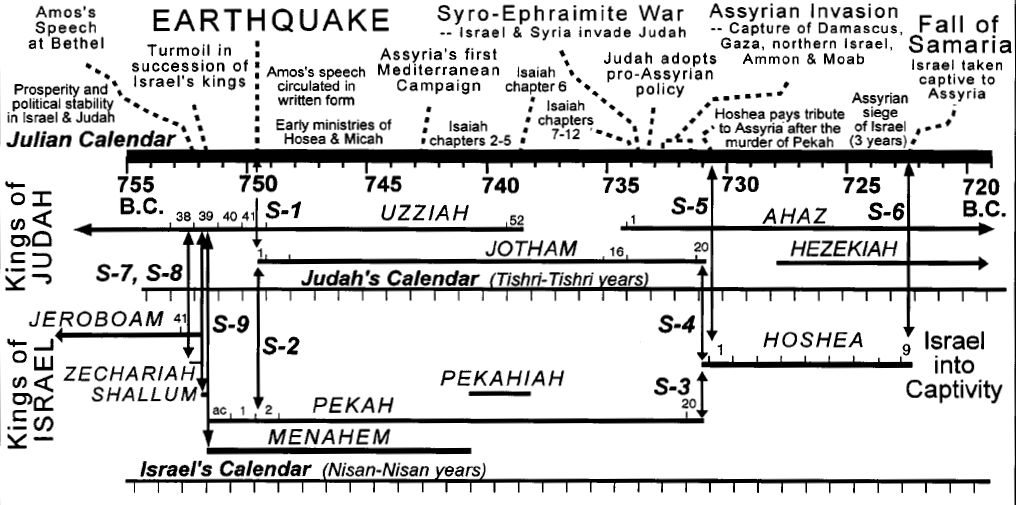 Fig. 6 - Time line showing the historical context and dating of Amos's earthquake.
Synchronisms, which are shown as vertical arrows under the time line, allow Amos's earthquake to be dated to 750 B.C.
The chronology of Hebrew kings follows Thiele (1983) with slight revisions by Finegan (1998).
Fig. 6 - Time line showing the historical context and dating of Amos's earthquake.
Synchronisms, which are shown as vertical arrows under the time line, allow Amos's earthquake to be dated to 750 B.C.
The chronology of Hebrew kings follows Thiele (1983) with slight revisions by Finegan (1998). from Onstott (2015)
from Onstott (2015)


